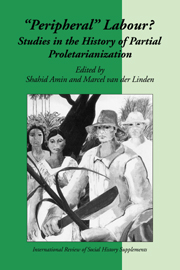Book contents
- Frontmatter
- Contents
- Introduction
- Colonialism, Capitalism and the Discourse of Freedom
- The Barriers to Proletarianization: Bolivian Mine Labour, 1826–1918
- Labour, Ecology and History in a Puerto Rican Plantation Region: “Classic” Rural Proletarians Revisited
- Coal and Colonialism: Production Relations in an Indian Coalfield, c. 1895–1947
- “Capital Spectacles in British Frames”: Capital, Empire and Indian Indentured Migration to the British Caribbean
- Unsettling the Household: Act VI (of 1901) and the Regulation of Women Migrants in Colonial Bengal
- Sordid Class, Dangerous Class? Observations on Parisian Ragpickers and their Cités During the Nineteenth Century
- Notes on Contributors
Unsettling the Household: Act VI (of 1901) and the Regulation of Women Migrants in Colonial Bengal
Published online by Cambridge University Press: 14 October 2009
- Frontmatter
- Contents
- Introduction
- Colonialism, Capitalism and the Discourse of Freedom
- The Barriers to Proletarianization: Bolivian Mine Labour, 1826–1918
- Labour, Ecology and History in a Puerto Rican Plantation Region: “Classic” Rural Proletarians Revisited
- Coal and Colonialism: Production Relations in an Indian Coalfield, c. 1895–1947
- “Capital Spectacles in British Frames”: Capital, Empire and Indian Indentured Migration to the British Caribbean
- Unsettling the Household: Act VI (of 1901) and the Regulation of Women Migrants in Colonial Bengal
- Sordid Class, Dangerous Class? Observations on Parisian Ragpickers and their Cités During the Nineteenth Century
- Notes on Contributors
Summary
The advent of capitalism has traditionally been associated with a transformation of the economic and political functioning of the family. Capital is presumed to weaken, certainly to modify, gender and age hierarchies by undermining the productive role of the household. The labour market takes over the organization of work and age of consent legislations undermine parental authority in order to create the new legal subject capable of entering “free” labour contracts. The family, though it remains outside the norms of capitalism, primarily undertakes the physical and social reproduction of labour within the capitalist sphere. Such a transformation of the “family” is, however, not inevitable. In nineteenth-century India the colonial state, though avowedly committed to a free market in labour, in practice often upheld familial claims on women's labour and sexuality. As a result, gender and generational controls within the family were enhanced rather than weakened.
Capitalist development in India was premised upon a simultaneous exploitation of domestic and capitalist relations of production. Colonial capitalism found it unnecessary to strip the domestic unit of its perceived economic functions. Under colonialism, the domestic organization continued to undertake both a vital part of the production and the physical reproduction of labour outside the capitalist sphere. Thus the accommodations between the family and the labour market acquired a distinctive character. The gender division of labour did not follow clearly demarcated domains of production and reproduction. Women were neither to provide cheap labour for capital, nor were they “domesticated” to provide a reserve army of labour. The household itself remained the site for the adjustments between productive and reproductive uses of women's labour.
- Type
- Chapter
- Information
- Peripheral LabourStudies in the History of Partial Proletarianization, pp. 135 - 156Publisher: Cambridge University PressPrint publication year: 1997
- 1
- Cited by



